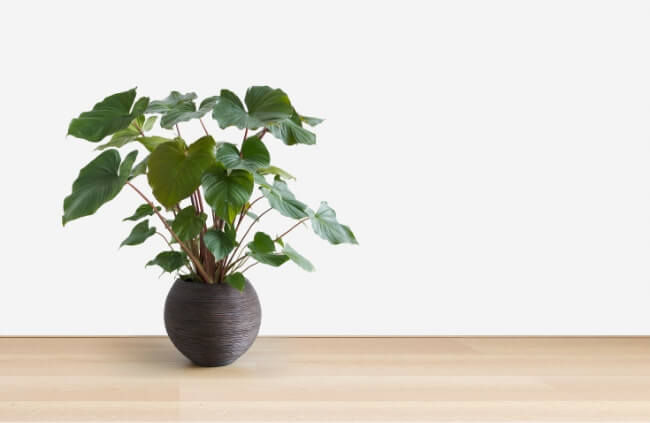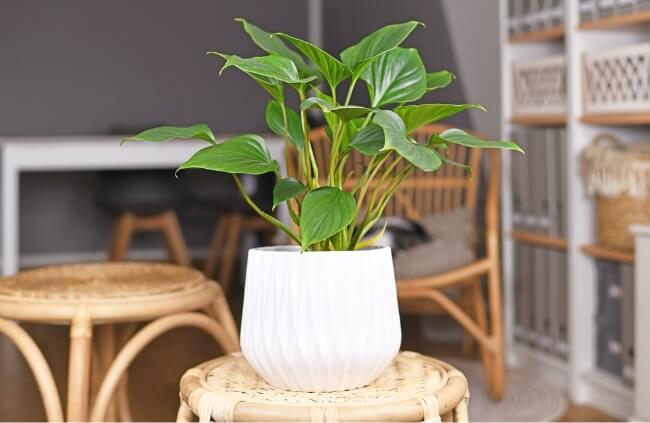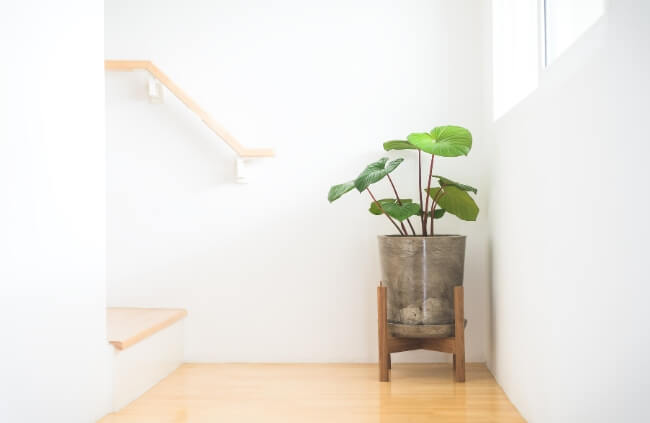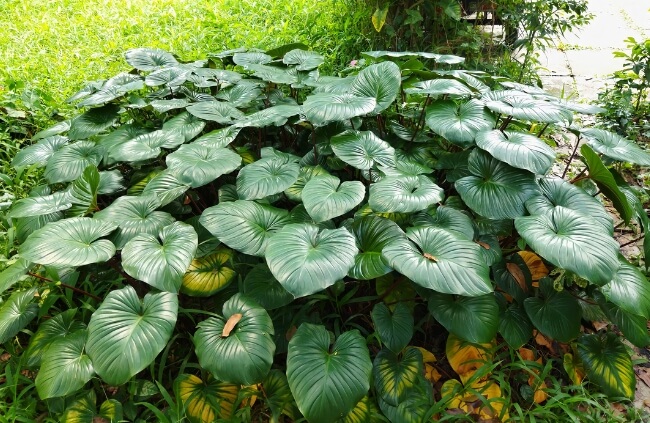From what I can tell, the unpopularity of Homalomena is due entirely to a lack of awareness. It is one of the easiest aroids to grow at home, and makes a stunning addition to living spaces, with gorgeous bold foliage that varies hugely between species and cultivars.
If you’re looking to expand your houseplant collection and want something genuinely unusual, read through our guide for information on how to grow these tolerant beauties and get inspired by some of the most spectacularly coloured houseplants imaginable in our list of 12 wonderful varieties of Homalomena.
More...

Family: | Araceae |
|---|---|
Genus: | Homalomena |
Species: | Various |
Common Names: | Shield plant, queen of hearts |
Origin: | Asia and the Southwestern Pacific |
Location: | Indoor |
Type: | Evergreen perennial |
Growth: | Varies by species |
Sun requirements: | Dappled light |
Foliage Colour: | Green, variegated or yellow-green |
Flower Colour: | White, or red and white |
Flowering: | Rarely indoors |
Edible Parts: | Some species have edible flowers, all other parts are toxic |
Maintenance level: | Medium |
Poisonous for pets: | Toxic to cats and dogs |
What is Homalomena?
As part of the vast Aroideae plant subfamily, there are a few features of Homalomena that are simply a given. Its flowers (spadix), for example, open like peace lilies, with tight pollen cones, and a single structural petal. Their leaves contain calcium oxalate, a common toxin that causes kidney stones in humans and pets.
Their roots produce leaves from the base, rather than stems. Unsurprisingly, Homalomena looks much like many other aroids, but with some clear distinctions, particularly around leaf shape, and root development.
In some cultures, Homalomena roots are used for traditional medicine, but they contain toxins that are not advisable for consumption.
Natural Habitat of Homalomena
The Homalomena genus is native to southern Asia and most of the southwestern Pacific, including New Zealand, Samoa, Fiji, Tonga, and New Guinea. They grow largely in warm, humid forests, where winters remain distinctly warm, and summers are incredibly wet, making them a good choice for bathrooms, and cementing their requirement for dappled light.
Different Types of Homalomena
There are over one hundred species of Homalomena, but just a handful are available for houseplant lovers to grow at home. Those suitable for indoor growing, with more controlled conditions, are included below, including one or two that might take a tiny bit more work to get right, but are well worth growing for their looks alone.

12 Homalomena Varieties to Grow at Home
1. Homalomena expedita (Water Alocasia)
Native to Borneo, Homalomena expedita, is generally found growing in bright swamps and mudflats where it enjoys very moist conditions and will even grow with saltwater as a moisture source.
If you’re looking for tough but beautiful house plants, they don’t come much tougher than Homalomena expedita, with its striking emerald leaves, which in some cultivars display delicate yellow veining.
2. Homalomena cordata (Heart Shaped Homalomena)
One popular Homalomena cultivar for houseplant lovers is Homalomena cordata, or the Heart Shaped Homalomena. Its large leaves can reach 25cm long, and almost as wide. With proper lighting and well-managed watering, it has deep green foliage and subtle but delightful pale patches in the centre of each leaf where it meets the petiole.
These moisture-loving plants do enjoy slightly drier but brighter winters, so managing their position if they are grown in a bathroom is important.
3. Homalomena ‘Platinum Velvet’
Silver-leaved houseplants are quite common these days, but chrome-leaved houseplants are rapidly growing in popularity, thanks to their iridescent foliage that shifts from reds to blue-greens all held together in a solid coat of powdery grey.
Homalomena ‘Platinum Velvet’ is perhaps the most undeniably chrome-coloured houseplant you can grow, and while it’s not common, it is very possible to find specimens for your houseplant collection from dedicated growers.
4. Homalomena ‘Pink Diamond’
Homalomena ‘Pink Diamond’ has boldly variegated leaves, often with complete separation in colour on either side of the midrib. Every leaf is a uniformly pointed arrowhead form, head on a single stalk, with new leaves emerging from the base of old ones as they fade.


Get Your Free Guide:
Master Growing Australian Natives eBook
A Must Have Complete Guide for Every Australian Garden
Get Your Free Guide:
Master Growing Australian Natives eBook
A Must Have Complete Guide for Every Australian Garden
The variegations do weaken these Homalomena cultivars, so make sure you regularly pinch out dead leaves to make way for new growth.
5. Homalomena rubescens
The crinkled, angular leaves of Homalomena rubescens are simple, clean and green, but they are by no means dull. Their bright red stems stand out against other light foliage and are slightly translucent. Placed in a bright bathroom they filter morning sunlight gorgeously, provided they are kept away from the hot glare of afternoon sun.
The simplicity of each leaf makes it a strong photosynthesizer, and a vigorous plant, so new growth will be plentiful, offering loads of opportunities to take cuttings and remove young plants from around the base.
6. Homalomena sekadau
Not all Homalomena are created equal, and some, including the stunning but small Homalomena sekadau are barely recognisable as part of the genus.
Not only are they limited to growing to just a few inches tall, they grow best under water. However, if you have an exceptionally high-humidity environment and are willing to mist regularly and maintain regular watering, mixed with very good drainage, they do grow in pots.
For best results, plant Homalomena sekadau into an aquarium with proper filtration.
7. Homalomena cf. aromatica
Variegations on Homalomena cf. aromatica vary pretty widely, with some leaves developing as a pure salmon-pink, while others will be nearly entirely black.
The unpredictability of these incredibly Homalomena hybrids is really quite joyful, but even if you found yourself with an entirely black, or entirely pink plant, it would likely be the most unusual and exciting house plant in your collection.
8. Homalomena sp. papua
Homalomena sp. papua is one of the simplest Homalomena varieties to get flowers from. Its flowers, like the rest of the plant, are small and do best in well-ventilated spaces with occasional humidity.
The elongated leaves, with eye-catching yellow streaks down their centre and deep-red stems, come together to create a truly special houseplant.
9. Homalomena ‘Red Velvet’
Occasionally sold under the name Homalomena ‘Red Velvet’, is a shockingly bicoloured hybrid, with deep-green leaves that are nearly black on the surface, but completely red on their undersides.
Deep veining adds texture and shadow, and depending on the age of each leaf, its underside colouring varies. Watching the development of these Homalomena hybrids is entirely captivating.
10. Homalomena hasei
This fluffy leafed Homalomena relies almost entirely on humidity but will grow in pots and containers. It is a lithophyte in the wild growing on limestone cliffs in humid woodlands and forests, where it benefits from bright but dappled light, and constant humidity, which it is perfectly adapted to catch and contain.
Grown in pure gravel or a very free-draining compost, Homalomena hasei can be grown in bathrooms and showers all year round.
11. Homalomena sp. Corong
Homalomena sp. Corong has many similarities with other aroids, including deeply divided bases to each leaf, forming sharp arrows on fine stems. While it’s not a particularly dense houseplant Homalomena sp Corong does grow to about 2ft tall and adds structure and presence to any setting.
12. Homalomena pendula
Homalomena pendula as a true species variety is incredibly hard to get hold of, and generally quite similar to other wide-leaved Homalomena, but there are some stunning cultivars, including H. pendula ‘Arrowhead’ and H. pendula ‘Albovariegata’.
Their defining characteristic is arrow-shaped leaves that are generally curved down at the tip.
How to Grow Homalomena
Good drainage, plenty of warmth, and regular drinks in dappled shade. That’s the best way to sum up what Homalomena needs from their carer. Essentially, recreating tropical forests as best as you can.
Like most house plants, Homalomena care is pretty intuitive, provided you get the potting mix right to begin with.

Growing Homalomena Indoors
The guide below focuses on recreating humid forest conditions in summer, and warm dry winters. While bathrooms provide ideal summer conditions, they can sometimes cause fungal problems for Homalomena over winter, so you must provide good ventilation to go with it.
Otherwise, aim for a slightly shaded spot in a living room or bedroom where their moisture levels can be better controlled.
Light & temperature
Firstly, Homalomena needs dappled light, or at the very least, bright indirect light. If you have other tall house plants, that will provide dappled light regardless of where they are. If not, place them at least 2m away from a bright window, where they can source just enough light to thrive.
Summer temperatures can vary for Homalomena, but winter temperatures need to stay above 18°C to ensure they retain foliage. If they drop below that they can defoliate and fungal problems are quite likely, but they generally recover well in spring.
Humidity
Humidity is important for Homalomena. Between each watering, mist them with a fine mist, or place them on a tray of pebbles, filled with water. This will protect roots and soil from excess moisture, but create a gentle increase in humidity around each plant.
Over summer, bathrooms are wonderful places for Homalomena, but winter humidity can cause fungal problems. But Homalomena can be moved without shock, so you can move it to a drier space for winter.
Soil & Drainage
The potting mix for Homalomena is crucial. It needs to retain enough moisture that it doesn’t dry out completely in summer, but won’t remain saturated in winter.
Mixing any peat-free compost with perlite and orchid bark works for me. The orchid bark retains moisture without harming roots, while the perlite supports drainage.
Once every few years, we shake off any old compost and replace it with new. Thanks to the rhizomatous roots, it’s really simple to re-pot.
Watering Homalomena
Homalomena doesn’t ever like to dry out completely. Aim to water when the soil is nearly dry, but not completely. Add a thin mulch of bark chips to the surface to prevent the soil surface from cracking. These can be composted and replaced every couple of years.
In our bathroom, Homalomena ‘Purple Sword’ needs watering once a fortnight. In the living room, it’s once every 7-10 days. Pay attention to your plant for the first few weeks. It will tell you how often to water it.
Growing Homalomena Outdoors
It is possible to grow Homalomena outdoors in Australia, but they need bright, warm, shaded growing conditions, and protection from damp winters. Through summer, they need plenty of irrigation during hot weather and don’t like to dry out at all.
If your garden ever drops below 18°C, it’s worth bringing them indoors for winter just in case too. But if you can offer them what they need, it’s more than possible to grow these gorgeous tropicals in your own garden.
How to Propagate Homalomena
Like nearly all aroids, Homalomena is best propagated from root cuttings or division. Seeds are a rarity for indoor growers, and they are slow to develop.
There are no stems to take cuttings from as leaves form, directly from the base, so the only option for propagation at home is either to divide the plant or lift it and take root cuttings.

Propagating Homalomena from Division
Dividing Homalomena is simple. You can either take pups as they develop, and plant them into a fresh potting mix, or cut straight through the root ball with a serrated knife to create two new mature plants instantly.
Both require fresh potting mix, and clean equipment, but are really simple to do.
To propagate pups, just prick out a pup using a pencil or screwdriver, taking as much root as possible (cut with scissors if needed). Then simply pop it into a small pot of compost, and water it well. Leave it somewhere bright and warm, and in a couple of weeks it should have vigorous signs of fresh growth.
For division, cut the root ball in half, starting between any natural divisions in the top growth. Repot the original plant with new compost, and repeat with the second half. Water them both well, and leave them in the same position as before for a few weeks to limit any transplant shock.
Homalomena Propagation from Root Cuttings
Root cuttings are fiddlier, but can potentially produce many more plants.
You’ll need to shake off the soil from your Homalomena root ball, and then tease away any finer roots. The aim is the thick rhizome, which with any luck will have small swollen bumps along its length.
The rhizomes grow parallel to the surface of the soil, and those bumps are potential new plants. Without removing more than 1/3 of the rhizome, try to cut away several 2” sections. Place these on tissue for a moment with the right side facing up (as it was in the pot).
Prepare a bed of reasonably well-drained potting mix in a seed tray, then place the cutting on (wiggling a bit to improve soil contact). Cover the root cuttings over lightly so they are just buried.
Then water it well, cover it with cling film or a sheet of clear plastic, and place it somewhere warm and bright, out of direct sunlight. The roots should develop quickly, and in less than two months they should have produced a new plant.
Homalomena Care Tips
Once established, Homalomena needs a moderate amount of care. None of it is difficult, but it’s definitely not low-maintenance.
Mulching Homalomena
Mulching Homalomena isn’t a necessity but I personally find it very useful. Adding a thin layer of bark chips to the surface of the pot allows me to water neatly without splashing the stems or leaves, and retains water, so I have to water less frequently too.
Particularly through warmer summers when some of our Homalomena head outside for a holiday, it makes sure they don’t dry out too quickly.
What Fertiliser to Use
Any basic houseplant feed does the trick with Aroids, and Homalomena really does appreciate it. Consider how your houseplants grow in nature. Desert plants like cacti and succulents don’t need feed. They thrive in free-draining poor soils, with no organic matter to speak of.
Aroids, and Homalomena in particular, are forest plants. They need annual mulches of fallen leaves, and soil life constantly churns up nutrients.
We use Osmocote’s pour and feed for houseplants as a simple top-up, but repotting into good compost every few years is the most important step in caring for any aroid.
Pruning and Repotting
Yellow leaves, damaged foliage, or spotted leaves are unlikely to recover and will drain energy from your Homalomena so cut them off at the base using clean scissors.
Other than that there are no pruning requirements for Homalomena.
Homalomena Winter Care
Homalomena will enter a dormant period in winter but remain evergreen. Avoid over-watering, but if the soil completely dried out, and the leaves look wilted, offer them a smaller-than-normal drink without any fertiliser.
Make sure they are protected from winter temperatures below 18°C and limit humidity if you can.
Common Homalomena Pests and Diseases
Homalomena suffer a great many pests and diseases. Their rhizomatous roots are sturdy, and if you do notice signs of root rot, it can be cut out, and other parts of the plant can be saved. Pests, particularly mealybug, are a problem for indoor Homalomena, and can build vast colonies on the top and bottom of the leaf, creating an unsightly fluffy appearance down the midrib.
The most effective way to get rid of any pests for large-leaved houseplants like Homalomena is to scrape them off and dispose of them. Spray neem oil or peppermint oil mixed with water after removing pests to deter future infestations.
Homalomena Frequently Asked Questions

Is Homalomena rare?
Technically Homalomena isn’t rare at all. It’s a plentiful plant in the wild and most species are safe from any threat of extinction. But in the horticultural trade, it is bizarrely rare and quite hard to get hold of.
Why is my Homalomena dying?
If you suspect your Homalomena is dying, and it’s showing signs like yellow leaves or significant wilting, the most likely cause is overwatering. While they shouldn’t be allowed to dry out completely, it’s important not to saturate their soil, and water less frequently in humid environments.
Does Homalomena flower?
Homalomena has beautiful flowers, though not quite as dramatic as some other Aroids. Its tightly curled spadix is wrapped in a silky petal, which is either white, red, or pink depending on the species.
Does Homalomena go dormant?
When grown indoors, Homalomena usually goes dormant through winter, but in some parts of Australia, they will continue growing all year round, and can even flower in the middle of winter.
How tall does Homalomena grow?
Some species of Homalomena can grow up to 1.5m tall, and 1m wide, though most cultivars reach less than 40cm tall in containers.
Wrapping Up Our Guide to Growing Homalomena in Australia
Provided you keep the moisture levels regular, and never too wet, Homalomena can be grown anywhere, but stick to the guide for the healthiest plants possible, and remember that it’s worth the effort, just for the sake of having something so special growing in your home.
Homalomena might not be the rarest sight in the world, but they’re far from common in the houseplant trade and will get plant lovers talking.
Published on October 7, 2023 by Maisie Blevins
Last Updated on September 20, 2024




